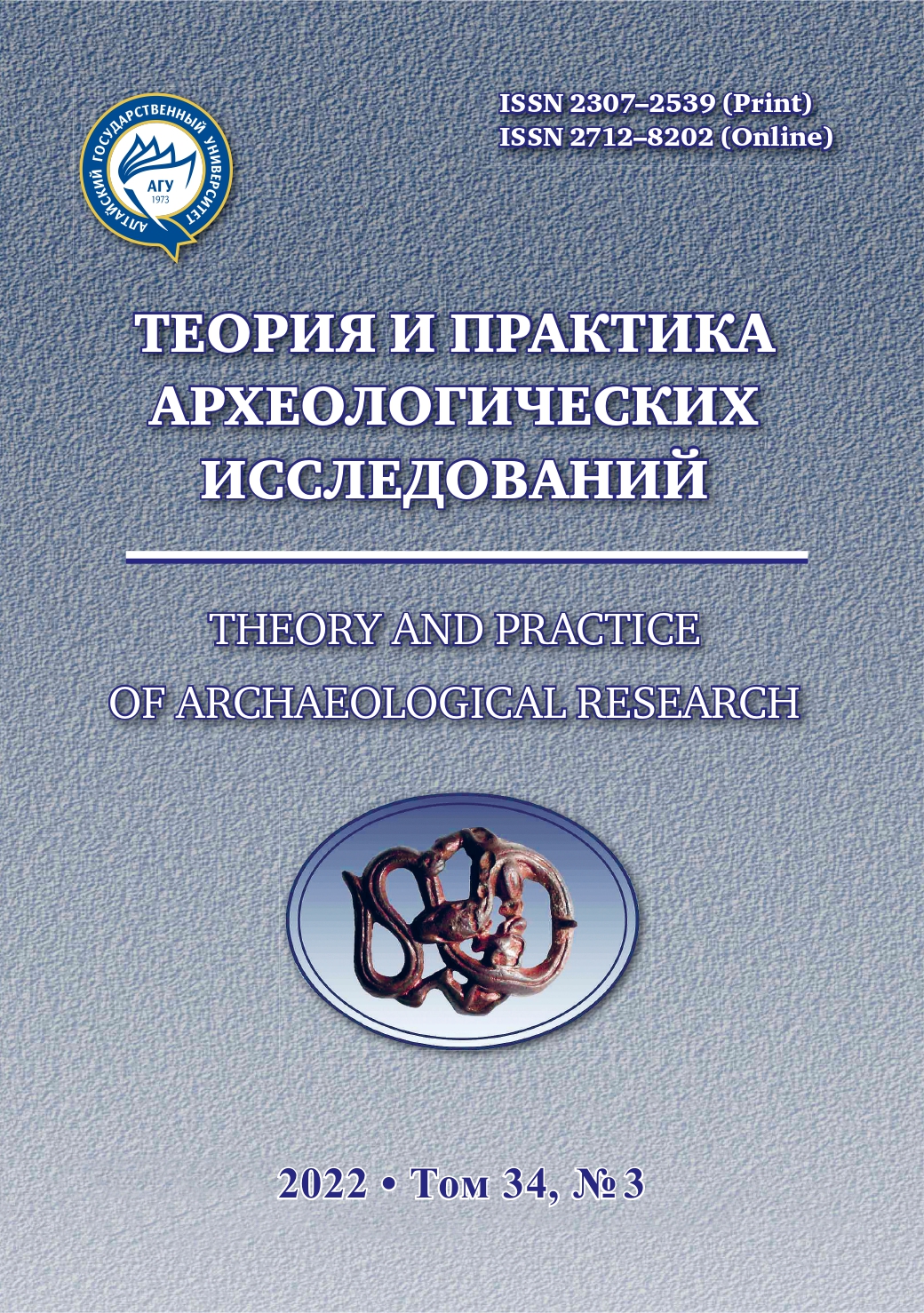ТЕХНОЛОГИЯ ОБРАБОТКИ И РИТУАЛЬНОЕ ИСПОЛЬЗОВАНИЕ ОБСИДИАНА В ДРЕВНИХ КУЛЬТУРАХ ПАСИФИКИ
Аннотация
В статье рассматриваются основные направления изучения обсидиана в тихоокеанском бассейне, включая (1) геохимическое, нацеленное на идентификацию источников вулканического стекла, использовавшегося в древних культурах; (2) технологическое, связанное с анализом методов обработки обсидиана, их эволюцией, а также экспериментами, и (3) культурный контекст, использование обсидиана в ритуальной практике, в формате престижных технологий и в декоративном искусстве. В то время как в геохимическом направлении достигнут серьезный прогресс, два других направления требуют дальнейшей разработки. Серия экспериментальных работ, проведенных в Приморье в 2020–2021 гг., позволила сделать весьма полезные наблюдения как по поводу особенностей местной сырьевой базы, так и по поводу поведенческой стороны процесса обработки обсидиана мастером и учениками (таких как обучение и наработка компетенций). В свою очередь, изучение особой роли обсидиана в культуре предполагает не только интерпретацию артефактов исключительного качества из кладов или погребений (ритуальная, престижная, неутилитарная), но и обращение к таким сюжетам, как контроль над источниками сырья, механизмы торговли/обмена, а также особый статус особо искусных мастеров по обработке камня в древних и традиционных обществах.
Скачивания
Metrics
Литература
Bradley B., Stanford D. Th e North Atlantic Ice-Edge Corridor: A Possible Paleolithic Route to the New World. World Archaeology. 2004;36(4):459–478.
Ebert C. E., Dennison M., Hirth K. G., McClure S. B., Kennett D. J. Formative Period Obsidian Exchange along the Pacifi c Coast of Mesoamerica. Archaeometry. 2015;57:54–73. doi.org/10.1111/arcm.12095
Fladmark K. R. Glass and Ice. Th e Archaeology of Mt. Fdziza. Department of Archaeology, Simon Fraser University, Burnaby, B.C., 1985. Publication Nо.14. 217 p.
Freund K. P. An Assessment of the Current Applications and Future Directions of Obsidian Sourcing Studies in Archaeological Research. Archaeometry. 2013;55:779–793. doi.org/10.1111/j.1475-4754.2012.00708.x
Gillam J. C., Tabarev A. V. On the Path of Upper-Paleolithic Obsidians in the Russian Far East. Current Research in the Pleistocene. 2004;21(1):3–6.
Glascock M. D., Krypianko A. A., Kuzmin Y. V., Shackley S. M., Tabarev A. V. Geochemical Characterization of Obsidian Artifacts from Prehistoric Sites in the Russian Far East: Initial Study. In: Archaeology of the Northern Pacifi ca. Vladivostok : Dal’press, 1996. P. 406–410.
Gould R. A. Th e Indians of Northwest California. Masterkey. 1985;59(2–3):2–21.
Hayden B. Practical and Prestige Technologies: Th e Evolution of Material Systems. Journal of Archaeological Method and Th eory. 1998;5(1):1–55.
Heizer R. F., Treganza A. E. Mines and Quarries of the Indians in California. Quaternary Chapter of the State Mineralogist’s Report. 1944;XL:291–359.
Hodgson S. F. “Obsidian Spirits Just Speak Once” — California Indians in a Geothermal Land. Paper Presented at World Geothermal Congress. Antalya, Turkey, 24–29 April, 2005.
Hughes R. E., Bettinger R.L. Obsidian and Prehistoric Sociocultural Systems in California. Exploring the Limits: Frontiers and Boundaries in Prehistory. BAR International Series. 1984;223:153–172.
Kimura H. Obsidian Human Technology. In: Paleoecology of Pleistocene and Stone Age Cultures of Northern Asia and Adjacent Territories. Novosibirsk : Institute of Archaeology and Ethnography Press, 1998. P. 302–314.
Kornfeld M., Tabarev A. Th e French Connection? Or Is It? Current Research in the Pleistocene. 2009;26:90–92.
Kroeber A. L. Handbook of the Indians of California. Bureau of American Ethnology Bulletin. 1925;78:995 p.
Kuzmin Y. V. Geochronology and Paleoenvironment in Late Paleolithic and Neolithic of Temperate East Asia. Vladivostok : Pacifi c Institute of Geography, 2005. 282 p. (In Russian with English summary).
Kuzmin Y. V. Long-distance Obsidian Transport in Prehistoric Northeast Asia. Bulletin of the Indo-Pacifi c Prehistory Association. 2012;32:1–5.
Kuzmin Y. V., Glascock M. D., Sato H. Sources of Archaeological Obsidian on Sakhalin Island (Russian Far East). Journal of Archaeological Science. 2002;27(7):741–749.
Kuzmin Y. V ., Oppenheimer C., Renfrew C. Global perspectives on Obsidian Studies in Archaeology. Quaternary International. 2020;542:41–53. doi.org/10.1016/j.quaint.2020.02.036
Kuzmin Y. V., Glascock M. D., Vorobei I. E., Grebennikov A.V. Sourcing of Obsidian Artefacts from the Omolon River Basin and the Neighboring Region (north-eastern Siberia): Prehistoric Procurement from Kamchatkan and Chukotkan Sources. Archaeometry. 2021;63:1141–1156. doi.org/10 .1111/arcm.12675
Kuzmin Y. V., Tabarev A. V., Popov V. K., Glascock M. D., Shackley M. S. Geochemical Source Analysis of Archaeological Obsidian in Primorye (Russian Far East). Current Research in the Pleistocene. 1999;16:97–99.
LeBlanc R. Wedges, Pieces Equillees, Bipolar Cores, and Other Th ings: An ‘Alternative to Shott’s View of Bipolar Industries. North American Archaeologist. 1992;13:1–14.
Popov A. N., Tabarev A. V. Neolithic Cultures of the Russian Far East: Technological Evolution and Cultural Sequence. Turkish Academy of Sciences Journal of Archaeology. 2008;11:41–62.
Popov A. N., Tabarev A. V. Lords of the Shell Rings: Boisman Neolithic Culture, Russian Far East / Seigneurs des anneaux sur coquilles: la culture néolithique de Boismanskaya, Extrême-Orient russe. Séances de la Société préhistorique française. 2016;6:393–408.
Popov A. N., Tabarev A. V. Th e Preagricultural Human Occupation of Primorye (Russian Far East). In: Handbook of East and Southeast Asian Archaeology. New York : Springer, 2017. P. 379–396. doi.org/10.1007/978-1-4939-6521-2_24
Popov A. N., Tabarev A. V., Mikishin Y. A. Neolithization and Ancient Landscapes in the Southern Primorye, Russian Far East. Journal of World Prehistory. 2014;27(3):247–261. doi.org/10.1007/s10963-014-9073-1
Powers S. Tribes of California. Contribution of North American Ethnology. 1877;3:645.
Rust H. N. Th e Obsidian Blades of California. American Anthropologist. 1905;7:688–689.
Shackley M. S., Glascock M. D., Kuzmin Y. V., Tabarev A. V. Geochemical Characterization of Archaeological Obsidian from the Russian Far East: A Pilot Study. Paper Presented at International Symposium on Archaeometry. University of Illinois of Urbana. Champaign, Urbana, 1996.
Shott M. On Bipolar Reduction and Splintered Pieces. North American Archaeologist. 1999;20(3):217–238.
Tabarev A. V. On the Dark Side of the Neolitisation: Evidences of Violence in the Neolithic Burials at Boisman-2 Site, Russian Far East. In: Neolithization and Modernization: Landscape History on East Asian Inland Seas. Kyoto : Nakanishi printing Co Ltd, 2009. P. 131–138.
Tabarev A. V. Blades and Microblades, Percussion and Pressure: Towards the Evolution of Lithic Technologies of the Stone Age Period, Russian Far East. In: Th e Emergence of Pressure Blade Making: From Origin to Modern Experimentation. New York : Springer, 2012. P. 329–346. doi.org/10.1007/978-1-4614-2003-3_13
Tabarev A. V. Th e Later Prehistory of the Russian Far East. In: Th e Cambridge World Prehistory. V. 2. East Asia and the Americas. New York : Cambridge University Press, 2014. P. 852–869. doi:10.1017/CHO9781139017831.058
Tabarev A. V., Ivanova D. A., Kanomata Y. Knap and Keep: Late Paleolithic-Neolithic Caches, Far East. Documenta Praehistorica. 2021;48:2–11. doi.org/10.4312/DP.48.7
Авторы, публикующиеся в данном журнале, соглашаются со следующими условиями:
a. Авторы сохраняют за собой права на авторство своей работы и предоставляют журналу право первой публикации этой работы с правом после публикации распространять работу на условиях лицензии Creative Commons Attribution License, которая позволяет другим лицам свободно распространять опубликованную работу с обязательной ссылокой на авторов оригинальной работы и оригинальную публикацию в этом журнале.
b. Авторы сохраняют право заключать отдельные договора на неэксклюзивное распространение работы в том виде, в котором она была опубликована этим журналом (например, размещать работу в электронном архиве учреждения или публиковать в составе монографии), с условием сохраниения ссылки на оригинальную публикацию в этом журнале. с. Политика журнала разрешает и поощряет размещение авторами в сети Интернет (например в институтском хранилище или на персональном сайте) рукописи работы как до ее подачи в редакцию, так и во время ее редакционной обработки, так как это способствует продуктивной научной дискуссии и положительно сказывается на оперативности и динамике цитирования статьи








2.jpg)




